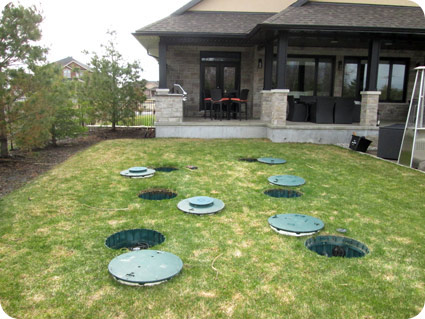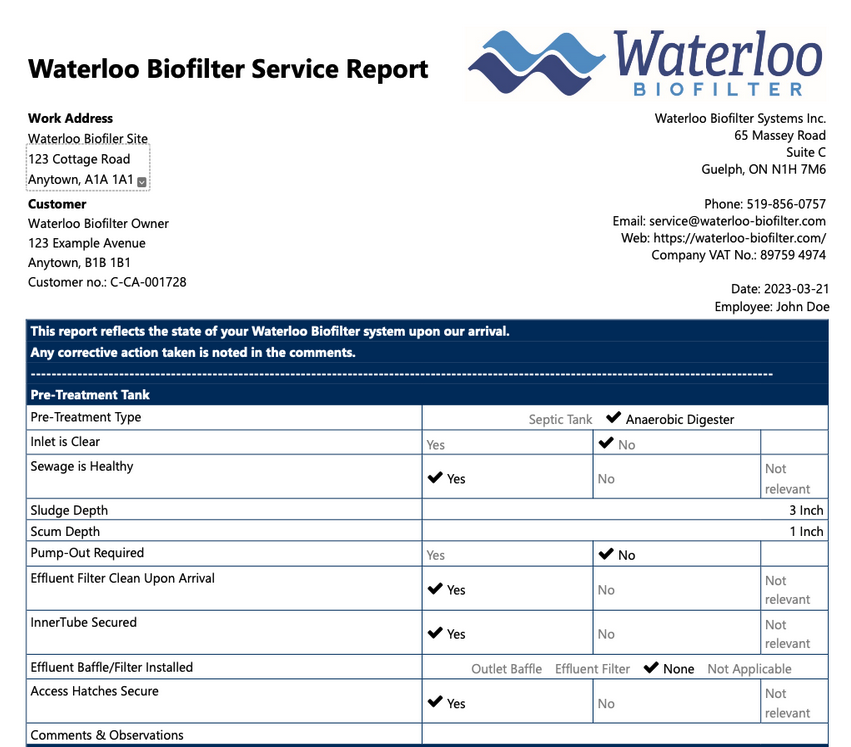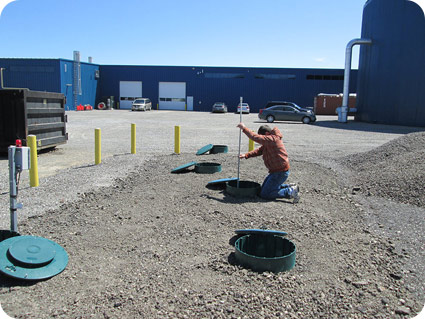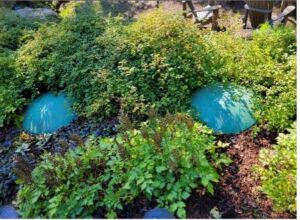Regular maintenance on your Waterloo Biofilter treatment system is essential for the protection of public health, drinking water resources, and property values.
Just like your car or your furnace, all septic systems benefit from regular attention to ensure that they are functioning as designed. Further, regular servicing will also extend the service life of your system and prevent costly repairs. Maintenance of Waterloo Biofilter treatment systems is also a requirement under multiple-source legislation.
Waterloo Biofilter’s team of certified and experienced wastewater technicians has been providing reliable operation and maintenance services since the early 2000s. We work in conjunction with onsite property managers and homeowners to optimize their systems to achieve the best results possible.
Residential Maintenance
In Ontario, residential dwellings, whether seasonal or year-round, are governed by Part 8 of the Ontario Building Code; Section 8.6 refers to tertiary systems and Section 8.9 refers to the operation and maintenance of the systems.
Owners can find the Homeowner Manual for their system by clicking the link below, Owners can also download and fill out a service agreement by selecting from the link below.
Have a question? See our Frequently Asked Questions

Understanding your maintenance reports
The Service Reports you receive from Waterloo Biofilter have a lot of important information in them. Check out our interactive guide to understanding your report for more information on what data is included and what it means for your system.

Business and Commercial Maintenance

Our service team maintains many of our commercial Waterloo Biofilter treatment systems in Ontario, sometimes in conjunction with trained site personnel or other local contractors. The size and complexity of the system typically dictates the frequency of service visits and sampling required by Ministry approvals. In addition to regular maintenance, we are able to undertake responsibility for all government sampling and reporting requirements. Our thorough understanding of the treatment technology allows us to optimize plant operations for best performance results.
Maintenance and Service FAQ
We require sites and systems to be fully accessible to our technicians so that they can do their work safely and efficiently. Private roads need to be passable to a light vehicle; our service technicians typically drive pickup trucks, sometimes with a trailer attached if they are bringing materials they cannot fit in their trucks. The property should be safe for the technicians when they are performing their inspection.
Lids should be at grade and visible; our technicians will not dig through gardens or move rocks in order to locate lids. If lids are located in a garden, the area should be marked, and no plants should be planted within two feet of each lid; the technicians need ample space to move around without trampling vegetation as they do their work. Internal components of the septic system, such as float trees, and plumbing, should also be within arms reach of ground level.
Control panels should be placed in an area where they can be easily located and accessible without obstructions.


Plants Are Too Close


Lids Should Not Be Covered


Obstructed by Decking


Obstructed by Decking


Behind A Bush


Under A Deck


Ideal Space Between Lids & Plants


Ideal Panel Location
“Grade” refers to the level of the land or your property. “Above grade” and “below grade” are terms commonly used in construction or landscaping and describe whether the item being described is above the ground or in/below the ground.
We require lids to be “at grade,” meaning level to the ground around it and not located under sod, dirt, gravel, or mulch. By being located at grade or slightly above, this will prevent foreign debris or insects that may clog your system from entering through the lids.


Placed Correctly At Grade


Placed Correctly At Grade


Placed Correctly At Grade


Placed Below Grade


Placed Below Grade


Placed Below Grade
Your service report will be included in the attachments emailed to you after your service visit has been completed. For every service visit you will receive an email with multiple attachments including your invoice, the technician’s report, and payment options. There may be additional attachments such as repair estimates, or septic system best practices. When a technician collects samples during a regular service inspection, you will receive the email containing the invoice and report only once we have received the sample results from the lab; lab testing can take 4-6 weeks in some circumstances.
Please ensure you review all attachments before calling the service department.
Please add [email protected] to your email’s safe sender list.
Your service contract includes your annual inspection, which is billed after the inspection has been completed and samples, if taken, have been tested and we have received the results back from the lab. Your service contract with Waterloo Biofilter also gives you priority customer status if your system is in alarm or need service outside of your annual inspection, which is billed separately at a preferred customer rate.
An inspection is necessary because:
• Provincial and municipal laws and regulations require wastewater and wastewater treatment systems to be inspected, please refer to the Ontario Building Code, Part 8, Section 8.9.2.3. for further details.
• Wastewater is an environmental concern because it goes into the ground where drinking water is drawn from.
• A maintenance plan is required to maintain the warranty on your Waterloo Biofilter filtration media.
• As a critical component of your property, regular maintenance protects your investment and can help prevent costly repairs due to neglect.
You will receive an email at the beginning of your regular service inspection season (spring, summer, fall) reminding you of the upcoming inspection. Please note we do not schedule appointments or specific dates and times to visit each property as there are many scheduling components that play a role, and changes to planned visits can happen up to the moment. As such, we do not call or email each individual property after the initial reminder email. You do not need to be home in order for the technician to service your septic system.
If you have not provided a current email address to receive reports and invoices, we will not be able to send your seasonal inspection notice.
You do not need to be home at the time of your inspection. The treatment system is located outside of your home and can be inspected without access to the home. If your property is locked or gated, owners will need to provide a gate code or leave their gate unlocked to allow access.
If you are not home when the technician comes to do service work, the technician may need to get a hold of you if there is an issue with the system that needs to be addressed. The technician may need the owner’s approval for fees associated with repairing or replacing a part, such as a float or a pump, or the technician may need to draw the Owner’s attention to a serious system performance issue. Providing Waterloo Biofilter with a current phone number where we can reach you allows issues to be resolved without requiring additional service visits.
The best location for the control panel to your septic system is for it to be located outdoors, on the exterior of the building near the septic system or alongside other utility panels such as your water, hydro, or gas meter. If the septic system is located a distance from the nearest building, some owners will install the control panel on a post located next to the septic system. Panels should not be located indoors, or have locks on the panel doors.


During the annual inspection the technician will perform a visual inspection of the condition and safety of all tanks, enclosures, and access hatches. With the lids open, the technician will examine the health of the system, including both the pre-treatment tank and the Biofilter treatment medium. The technician will test the operation of the pumps and floats to ensure they are operating, and will assess the spray nozzles, clean the nozzles as needed, and adjust them to promote even distribution of the sewage as it sprays over the Biofilter medium. The control panel is checked, and the settings are adjusted as needed. Where available, the technicians will collect samples of either or both, the sewage and the final discharge for lab testing. The technicians also assess the leaching bed area and make notes where needed; repairing leaching beds is beyond our scope. Finally, the technicians close and secure all the lids and ensure the system is returned to its regular operating mode before leaving. After completing the inspection, the technicians spend time entering their observations and notes, recording measurements and data collected on site, recording any adjustments or minor repairs they made to the system, and any recommendations or actions that need to be taken by the owner. The technician is recording a snapshot of your system as it appears or functions on that day.
As a general rule of thumb our technicians aim to let their presence on the property be known. When a technician arrives, they will knock and attempt to make contact with the owner. In addition to making notes about their findings and actions when doing an inspection, technicians also take photos for reference.
You will receive your inspection report with the invoice at the email address you have provided to us, approximately 6-8 weeks after the inspection. For a preview of what your report will look like, see the sample report and instructions on what your report means.
Alarms in a septic system can be due to several reasons. If your control panel goes into alarm, you can call Waterloo Biofilter and request a technician come and diagnose the alarm and make repairs where needed. Waterloo Biofilter technicians did not install your system and cannot warrant any work done by the installer. Service visits to new installs with alarms will be billed at the applicable service callout rate. Alarms in a newly installed system can be related to several install related issues such as packing and installation debris being left in the tank and getting sucked into pumps, or floats that were wired incorrectly. Most installers want to have a good reputation and happy customers can boost their business so many installers will come back to correct their mistake if the owner calls them.
Products marketed as “flushable” are not suited to privately owned and maintained wastewater treatment systems. Flushable products are typically targeted at consumers who use municipal wastewater treatment where there are active mechanical devices being used to break down degradable products quickly and efficiently. The Waterloo Biofilter treatment system thrives on retention and breakdown of matter through bacteria; flushable products clog the system and prevent effective breakdown of biological waste.
The frequency of septic tank pump outs will vary from system to system and there is not set frequency. The Ontario Building Code requires septic tanks be pumped out when the sludge and scum measurements combined reach a measurement that is 1/3 of the operating capacity of the septic tank. During your regular service inspection, the technician will advise is the sludge and scum has reached 1/3 of the operating capacity and requires a pump out, or if they recommend the septic tank be pumped out for another reason, such as the presence of debris or an unhealthy tank environment. Please click here for an instructional video on how to pump out an Anaerobic Digester.
When you purchase a Waterloo Biofilter Systems Inc. wastewater treatment system there is a limited manufacturer’s warranty that will cover manufacturer defects in components such as pumps, floats, and the Biofilter medium; please refer to your owner’s manual for details. Travel and labour fees to repair any warrantied parts is not covered under warranty and owners will be billed at the service callout rates. Waterloo Biofilter Systems Inc. offers an extended pump warranty for a total of five years of coverage which is available for purchase at the time the pump is purchased.
The compaction of soil covering your septic system’s components may occur with the use of heavy equipment, vehicular traffic, gazebos, patios, or storage and placement of large and heavy items such as swimming pools, playgrounds, and skating rinks can cause compaction to the soil covering the system. Compacted soil cuts off or limits the oxygen supply to the micro-organisms in the soil. These micro-organisms are essential to maintaining soil and ground integrity and the disbursement of discharged effluent. This may result in less-than-optimal functioning of the disposal bed, or even loss of functioning altogether. In the winter, owners should be aware that ATVs and snowmobiles, excessive snow loads from plowed driveways and parking lots, or backyard skating rinks, can cause compaction which drives frost into the system.
To promote healthy bacteria growth to increase performance of your system we recommend using a biological additive to enhance the existing bacteria. On request, our technicians can provide an additive to the system on a service visit, or owners can purchase consumer grade biological additives. The product EcoEthic has been shown to work well with our systems.
As a living organism, the bacteria is likewise affected by the cold and if your system is healthy, there should be no concerns of bacteria dying off; the bacteria in the system will adjust to the lack of use and slow its digestion, but will be ok until spring when the system is started again.
The best location for the control panel to your septic system is for it to be located outdoors, on the exterior of the building near the septic system or alongside other utility panels such as your water, hydro, or gas meter. If the septic system is located a distance from the nearest building, some owners will install the control panel on a post located next to the septic system. Panels should not be located indoors, or have locks on the panel doors.


Owners will notice the foam appears dry from the exterior, but the interior of the foam is still damp enough. The bacteria retreat into the centre of the foam blocks where there is still dampness and go dormant rather than die out. Once new sewage is reintroduced, the entire foam volume will become a livable environment for the bacteria again and treatment should kickstart on its own. For situations where this may not happen, we can provide a bacterial product we call septic jumpstart which can be dumped into the Biofilter dosing tank. This additive introduces additional bacterial colony to the foam media.
Proactive and competent owners can easily clean their filters by opening the lids, removing the filters, and hosing them off. Owners should ensure their own safety and not attempt if uncertain as the tanks are confined spaces which can pose a danger, and that sewage gases or material may escape when lids are opened. Best practice when handling biological waste is to wear safety goggles, gloves, and to protect their clothing.
 Needs Cleaning
Needs Cleaning Needs Cleaning
Needs Cleaning After Cleaning
After Cleaning After Cleaning
After Cleaning
Need to speak to the Service Department?
Please email or call at:
[email protected]
1-866-366-4329 (toll-free) | (519) 856-0757

